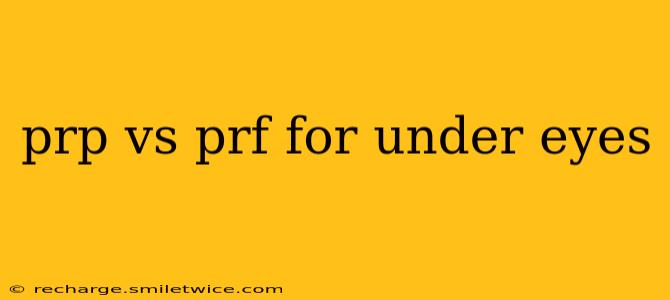The delicate skin under the eyes is prone to showing signs of aging, including dark circles, wrinkles, and hollowness. Platelet-rich plasma (PRP) and platelet-rich fibrin (PRF) are two innovative treatments gaining popularity for revitalizing this sensitive area. Both harness the power of your own blood to stimulate collagen production and improve skin texture, but they differ in their preparation and potential benefits. This comprehensive guide will delve into the key distinctions between PRP and PRF for under-eye rejuvenation, helping you make an informed decision about which treatment might be best suited for your needs.
What is PRP?
PRP, or platelet-rich plasma, involves drawing a sample of your blood, centrifuging it to concentrate the platelets, and then injecting the platelet-rich plasma back into the treatment area. Platelets are rich in growth factors that stimulate cell regeneration and collagen production, leading to improved skin tone, texture, and reduced wrinkles.
What is PRF?
PRF, or platelet-rich fibrin, is a more advanced, second-generation version of PRP. Similar to PRP, a blood sample is taken, but it undergoes a different centrifugation process. This creates a fibrin matrix that contains a higher concentration of growth factors and cytokines compared to PRP. The fibrin matrix acts as a scaffold, slowly releasing these growth factors over time, potentially leading to more sustained results.
PRP vs. PRF: Key Differences
While both treatments utilize the body's natural healing mechanisms, several key differences set them apart:
-
Preparation: The centrifugation process is the primary difference. PRF utilizes a lower centrifugation speed and no additives, resulting in a more natural, concentrated fibrin matrix. PRP often involves adding anticoagulants or other additives during the process.
-
Growth Factor Concentration: PRF generally contains a higher concentration of growth factors and cytokines, potentially leading to more robust tissue regeneration.
-
Release of Growth Factors: PRF's fibrin matrix provides a slow and sustained release of growth factors, potentially leading to longer-lasting results compared to PRP.
-
Cost: PRF treatment can sometimes be slightly more expensive than PRP, due to the more complex preparation method.
-
Treatment Time: The treatment time for both procedures is fairly similar.
What are the Benefits of PRP and PRF for Under Eyes?
Both PRP and PRF offer several benefits for under-eye rejuvenation:
- Improved Skin Tone and Texture: Increased collagen production leads to smoother, firmer skin.
- Reduced Dark Circles: Improved blood circulation and collagen stimulation can help minimize the appearance of dark circles.
- Reduced Fine Lines and Wrinkles: Collagen stimulation helps plump up the skin, reducing the appearance of wrinkles.
- Minimally Invasive: Both procedures are minimally invasive, requiring minimal downtime.
- Natural Results: Both use your own blood, so the results are natural and complement your existing features.
Which is Better for Under-Eye Treatment: PRP or PRF?
There's no single definitive answer to which treatment is "better." The ideal choice depends on individual factors, including the extent of under-eye concerns, budget, and personal preferences. Consult a qualified and experienced medical professional to determine which treatment best suits your specific needs and expectations. They can assess your skin type, the severity of your concerns, and discuss the potential benefits and risks of each procedure.
How Long Do the Results Last?
The longevity of results varies depending on individual factors, such as age, skin type, lifestyle, and the chosen treatment. Generally, both PRP and PRF treatments provide gradual improvement over several weeks, with results lasting anywhere from several months to a year or more. Maintenance treatments may be recommended to sustain the improvements.
Are There Any Side Effects?
Side effects are generally mild and temporary. Possible side effects include bruising, swelling, and redness at the injection site. These usually resolve within a few days.
What Should I Expect During and After Treatment?
The procedure is relatively straightforward and involves minimal discomfort. After the treatment, you might experience some mild swelling or bruising, which should subside within a few days. Your doctor will provide specific post-treatment instructions to ensure optimal healing.
Conclusion
Both PRP and PRF offer promising solutions for under-eye rejuvenation. The choice between them depends on individual circumstances and preferences. A consultation with a qualified medical professional is essential to determine the best course of action for achieving your desired results. Remember to choose a provider with extensive experience and a proven track record in these procedures.
